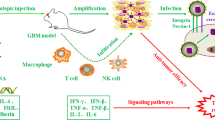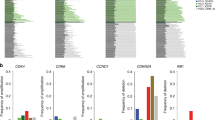Abstract
Novel therapies are clearly needed for gliomas, and the combination of oncolytic vectors with chemotherapy possesses a significant hope for the treatment of this malignancy. In addition, combination with chemotherapy allows for lower virus doses to achieve anticancer effect, thus resulting in lower undesirable toxicities due to viral proteins. In this work, we sought to determine whether combination of an oncolytic adenovirus ICOVIR-5, with RAD001 or temozolomide (TMZ) could result in enhanced anti-glioma effect in vivo. We assessed the in vitro cytotoxic effect and replication properties of ICOVIR-5 in combination with RAD001 or TMZ in U87 MG glioma cell line by MTT and TCID50, respectively. Our data showed that in vitro treatment with RAD001 or TMZ not only interfered with adenovirus replication but, in addition, enhanced its oncolytic properties. To evaluate the in vivo anticancer effect, athymic mice bearing glioma xenografts (5 × 105 U87 MG cells/animal) received a single intratumoral injection of ICOVIR-5 (107 PFU/animal). RAD001 was given as a regimen of 5 mg/kg 5 days per week until the end of the experiment and TMZ was administered for 5 days at 7.5 mg/kg/mice. Of significance, combination of ICOVIR-5 with RAD001 or TMZ showed a potent anti-glioma effect in vivo, resulting in a dramatic extension of the median animal survival and in 20–40% animals becoming free of disease beyond 90 days.
This is a preview of subscription content, access via your institution
Access options
Subscribe to this journal
Receive 12 print issues and online access
$259.00 per year
only $21.58 per issue
Buy this article
- Purchase on Springer Link
- Instant access to full article PDF
Prices may be subject to local taxes which are calculated during checkout


Similar content being viewed by others
References
Maher EA, Furnari FB, Bachoo RM, Rowitch DH, Louis DN, Cavenee WK et al. Malignant glioma: genetics and biology of a grave matter. Genes Dev 200; 15: 1311–1333.
Fueyo J, Alemany R, Gomez-Manzano C, Fuller GN, Khan A, Conrad CA et al. Preclinical characterization of the antiglioma activity of a tropism-enhanced adenovirus targeted to the retinoblastoma pathway. J Natl Cancer Inst 2003; 95: 652–660.
Fueyo J, Gomez-Manzano C, Alemany R, Lee PS, McDonnell TJ, Mitlianga P et al. A mutant oncolytic adenovirus targeting the Rb pathway produces anti-glioma effect in vivo. Oncogene 2000; 19: 2–12.
Majem M, Cascallo M, Bayo-Puxan N, Mesia R, Germa JR, Alemany R . Control of E1A under an E2F-1 promoter insulated with the myotonic dystrophy locus insulator reduces the toxicity of oncolytic adenovirus Ad-Delta24RGD. Cancer Gene Ther 2006; 13: 696–705.
Friedman A, Tian JP, Fulci G, Chiocca EA, Wang J . Glioma virotherapy: effects of innate immune suppression and increased viral replication capacity. Cancer Res 2006; 66: 2314–2319.
Guba M, von Breitenbuch P, Steinbauer M, Koehl G, Flegel S, Hornung M et al. Rapamycin inhibits primary and metastatic tumor growth by antiangiogenesis: involvement of vascular endothelial growth factor. Nat Med 2002; 8: 128–135.
Homicsko K, Lukashev A, Iggo RD . RAD001 (everolimus) improves the efficacy of replicating adenoviruses that target colon cancer. Cancer Res 2005; 65: 6882–6890.
Stupp R, van den Bent MJ, Hegi ME . Optimal role of temozolomide in the treatment of malignant gliomas. Cur Neurol Neurosci Rep 2005; 5: 198–206.
Chou TC, Talalay P . Generalized equations for the analysis of inhibitions of Michaelis–Menten and higher order kinetic systems with two or more mutually exclusive and nonexclusive inhibitors. Eur J Biochem 1981; 115: 207–216.
Chou TC, Talalay P . Quantitative analysis of dose-effect relationships: the combined effects of multiple drugs or enzyme inhibitors. Adv Enzyme Regul 1984; 22: 27–55.
Johnson L, Shen A, Boyle L, Kunich J, Pandey K, Lemmon M et al. Selectively replicating adenoviruses targeting deregulated E2F activity are potent, systemic antitumor agents. Cancer Cell 2002; 1: 325–337.
Aghi M, Rabkin S, Martuza RL . Effect of chemotherapy-induced DNA repair on oncolytic herpes simplex viral replication. J Natl Cancer Inst 2006; 98: 38–50. 13.
Chu RL, Post DE, Khuri FR, Van Meir EG . Use of replicating oncolytic adenoviruses in combination therapy for cancer. Clin Cancer Res 2004; 10: 5299–5312.
Acknowledgements
We thank Verlene Henry and Jennifer Edge for technical assistance with the animal experiments, and Betty P Notzon (Department of Scientific Publications, University of Texas MD Anderson Cancer Center) for editorial assistance. This work was supported by the National Cancer Institute RO1 CA90879 (JF). MMA is supported by the American Brain Tumor Association (ABTA) ‘Harper Rowland’ fellowship.
Author information
Authors and Affiliations
Corresponding author
Additional information
Supplementary Information accompanies the paper on Cancer Gene Therapy website (http://www.nature.com/cgt)
Supplementary information
Rights and permissions
About this article
Cite this article
Alonso, M., Gomez-Manzano, C., Jiang, H. et al. Combination of the oncolytic adenovirus ICOVIR-5 with chemotherapy provides enhanced anti-glioma effect in vivo. Cancer Gene Ther 14, 756–761 (2007). https://doi.org/10.1038/sj.cgt.7701067
Received:
Revised:
Accepted:
Published:
Issue Date:
DOI: https://doi.org/10.1038/sj.cgt.7701067
Keywords
This article is cited by
-
Lithium enhances the antitumour effect of temozolomide against TP53 wild-type glioblastoma cells via NFAT1/FasL signalling
British Journal of Cancer (2017)
-
Oncolytic virotherapy for urological cancers
Nature Reviews Urology (2016)
-
In vitro screening of clinical drugs identifies sensitizers of oncolytic viral therapy in glioblastoma stem-like cells
Gene Therapy (2015)
-
Bortezomib sensitizes non-small cell lung cancer to mesenchymal stromal cell-delivered inducible caspase-9-mediated cytotoxicity
Cancer Gene Therapy (2014)
-
Oncolytic Adenovirus With Temozolomide Induces Autophagy and Antitumor Immune Responses in Cancer Patients
Molecular Therapy (2013)



